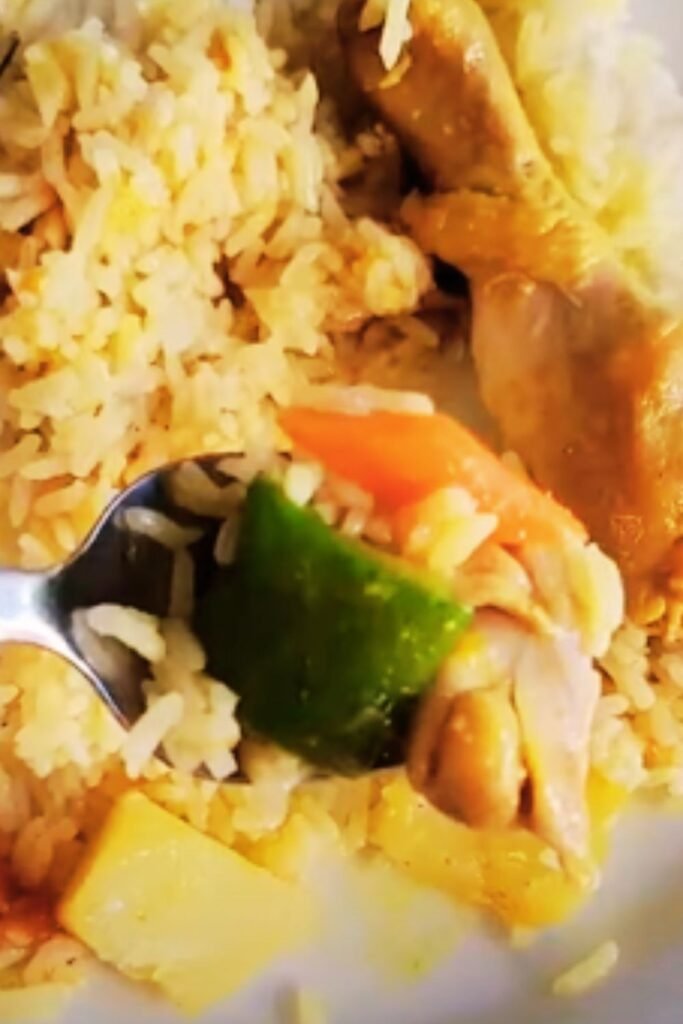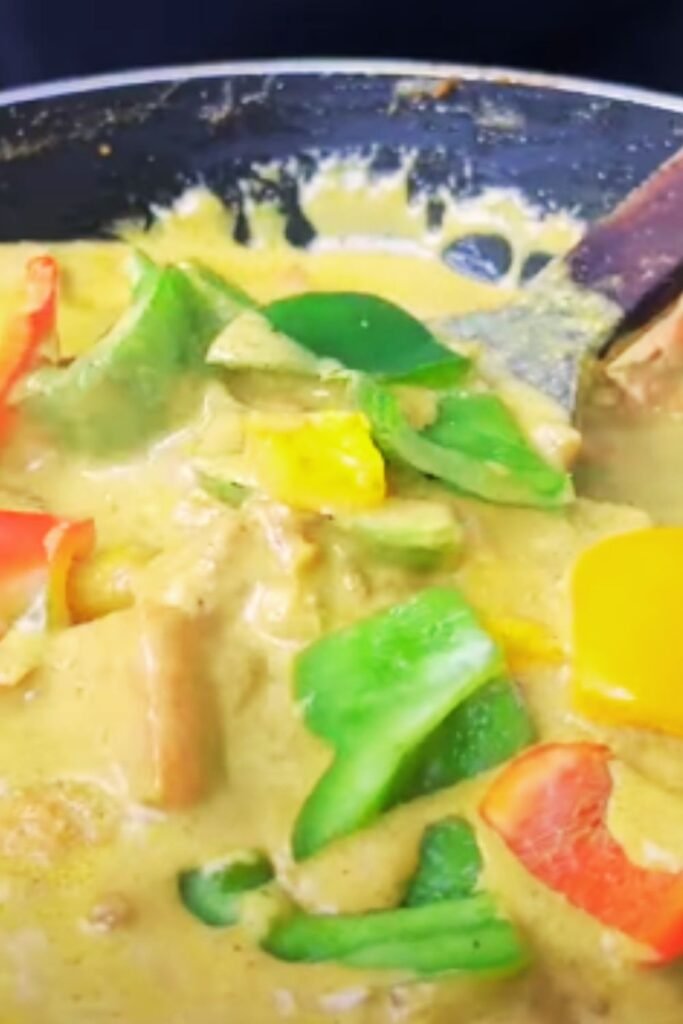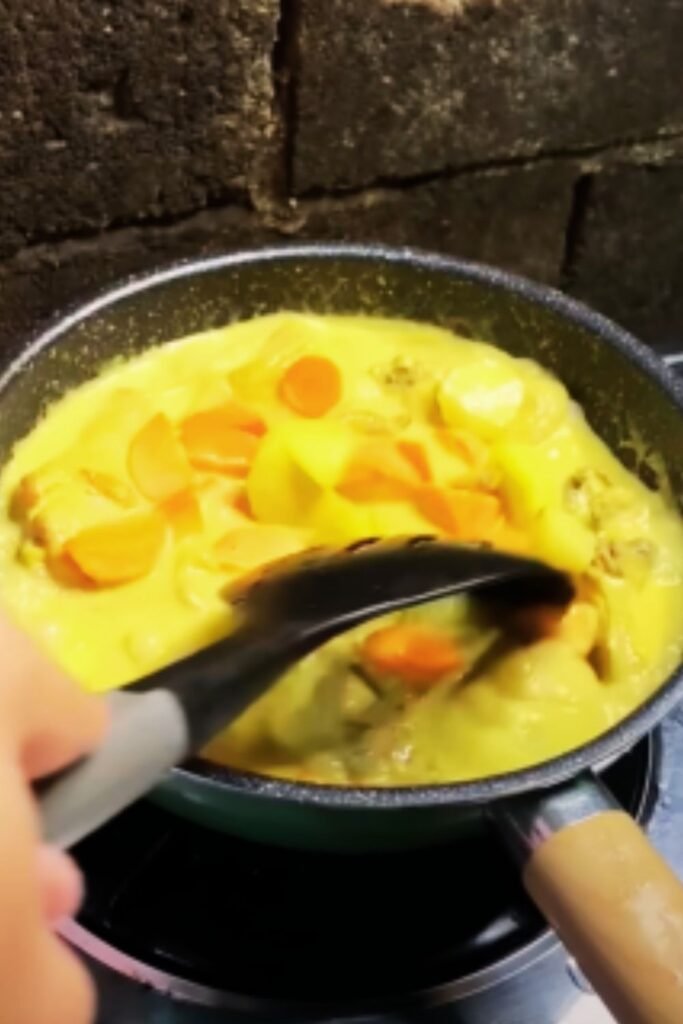There’s something incredibly comforting about a steaming bowl of Filipino-style chicken curry. When I first learned to make this dish from my neighbor who grew up in Manila, I was surprised by how different it was from the Indian and Thai curries I was familiar with. The Filipino version has its own unique personality – it’s milder, slightly sweet from the coconut milk, and features vegetables like potatoes and bell peppers that soak up all those wonderful flavors.
Today, I’m excited to share my perfected recipe for Filipino chicken curry, or what locals call “Kare-Kare ng Manok.” This dish brings together the perfect balance of spices, tender chicken, and creamy coconut milk for a meal that will transport your taste buds straight to the Philippines.
The Heart of Filipino Cuisine
Filipino cuisine often gets overshadowed by its more famous Asian neighbors, but the food of the Philippines represents a fascinating fusion of indigenous cooking methods with Spanish, Chinese, Malay, and American influences. This chicken curry reflects that beautiful cultural blend.
What makes Filipino curry unique is its mild yet complex flavor profile. Unlike its spicier counterparts from other Asian countries, Filipino curry is approachable for those who might be sensitive to heat while still delivering big on flavor. The curry powder used in Filipino cooking was introduced during the American colonial period and has been adapted to suit local tastes.
Ingredients You’ll Need
For this recipe, we’ll need ingredients that are likely already in your pantry, along with a few specialty items that can be found at most Asian grocery stores or even in the international aisle of your supermarket.
For the Chicken Marinade:
- 2 pounds chicken thighs and legs, bone-in and skin-on
- 3 tablespoons fish sauce (patis)
- 1 tablespoon calamansi juice (or lime juice)
- 2 teaspoons freshly ground black pepper
For the Curry:
- 3 tablespoons vegetable oil
- 1 large onion, diced
- 5 garlic cloves, minced
- 2 tablespoons ginger, finely chopped
- 2 medium potatoes, cubed into 1-inch pieces
- 2 medium carrots, sliced diagonally
- 1 red bell pepper, sliced into strips
- 1 green bell pepper, sliced into strips
- 3 tablespoons curry powder
- 1 tablespoon turmeric powder
- 2 bay leaves
- 2 cups chicken broth
- 1 can (14 oz) coconut milk
- 1 tablespoon brown sugar
- Salt to taste
- 3 tablespoons fish sauce (adjust according to taste)
- 2 tablespoons cornstarch mixed with 3 tablespoons water (optional, for thickening)
- Fresh cilantro and green onions for garnish
Kitchen Equipment
Having the right tools will make your cooking experience much more enjoyable:
- Large mixing bowl for marinating
- Heavy-bottomed pot or Dutch oven
- Sharp chef’s knife
- Cutting board
- Wooden spoon or heat-resistant spatula
- Measuring cups and spoons
Preparation Method
Let’s break down the process into manageable steps:
Step 1: Marinate the Chicken
- In a large bowl, combine the chicken pieces with fish sauce, calamansi or lime juice, and black pepper.
- Mix well, ensuring all chicken pieces are coated with the marinade.
- Cover and refrigerate for at least 30 minutes, though 2 hours will yield better flavor. If you’re short on time, even 15 minutes will do.

Step 2: Prepare the Vegetables
- While the chicken is marinating, prepare your vegetables.
- Peel and cube the potatoes into 1-inch chunks.
- Slice the carrots diagonally.
- Cut the bell peppers into strips.
- Dice the onion and mince the garlic and ginger.
Step 3: Sear the Chicken
- Heat oil in a large pot or Dutch oven over medium-high heat.
- Remove chicken from marinade, patting dry with paper towels (this helps achieve a better sear).
- Sear the chicken pieces in batches, about 3-4 minutes per side until golden brown.
- Set aside the seared chicken on a plate.
Step 4: Build Your Flavor Base
- In the same pot with the remaining oil and chicken drippings, add the diced onions. Sauté for 2-3 minutes until translucent.
- Add the minced garlic and ginger. Cook for another minute until fragrant.
- Stir in the curry powder and turmeric. Toast the spices for about 30 seconds to release their flavors and aromas.
Step 5: Create the Curry
- Return the seared chicken to the pot.
- Add bay leaves and chicken broth, scraping any browned bits from the bottom of the pot.
- Bring to a simmer, then cover and cook for 15 minutes.
- Add the potatoes and carrots. Continue to simmer covered for another 10 minutes.
- Pour in the coconut milk and add brown sugar. Stir gently.
- Add bell peppers and simmer for an additional 5-7 minutes until vegetables are tender but not mushy.
- If you prefer a thicker sauce, stir in the cornstarch slurry and cook for another 2-3 minutes until the sauce thickens.
- Adjust seasoning with fish sauce and salt as needed.

Step 6: Finish and Serve
- Turn off the heat and let the curry rest for 5 minutes to allow flavors to meld.
- Remove bay leaves before serving.
- Garnish with fresh cilantro and sliced green onions.
- Serve hot with steamed white rice.
The Role of Ingredients in Filipino Chicken Curry
Understanding the purpose of each ingredient helps you appreciate this dish even more:
Chicken
I recommend using bone-in, skin-on chicken pieces as they add more flavor to the curry. Thighs and legs work best because they remain juicy and tender during the longer cooking process. If you prefer boneless chicken, reduce the cooking time by about 5 minutes.
Curry Powder
Filipino curry powder is milder than its Indian or Thai counterparts. It typically contains a blend of coriander, turmeric, cumin, fenugreek, and other spices. If you can find Filipino curry powder (often labeled as “Oriental curry powder”), that’s ideal. Otherwise, a standard mild curry powder works well.
Coconut Milk
This provides the creamy texture and subtle sweetness that distinguishes Filipino curry. Use full-fat coconut milk for the best flavor and texture. Light coconut milk can be substituted, but the curry won’t be as rich.
Fish Sauce (Patis)
This fermented condiment adds umami depth to the dish. If you’re new to fish sauce, start with less and adjust to taste. Though it smells pungent on its own, it transforms when cooked with other ingredients.
Calamansi
This small citrus fruit is a staple in Filipino cuisine. If you can’t find calamansi, lime or lemon juice makes a good substitute.
Vegetables
The standard vegetables in Filipino chicken curry are potatoes, carrots, and bell peppers. Some families also add eggplant, string beans, or chayote. Feel free to customize based on your preferences.
Nutritional Information
For those watching their dietary intake, here’s a breakdown of the approximate nutritional content per serving (assuming 6 servings from this recipe):
| Nutrient | Amount per Serving |
|---|---|
| Calories | 410 kcal |
| Protein | 28g |
| Carbohydrates | 18g |
| Dietary Fiber | 3g |
| Sugars | 5g |
| Fat | 27g |
| Saturated Fat | 12g |
| Sodium | 850mg |
| Potassium | 620mg |
| Vitamin A | 70% DV |
| Vitamin C | 85% DV |
| Calcium | 4% DV |
| Iron | 15% DV |
Serving Suggestions
Filipino chicken curry pairs beautifully with several side dishes:
- Steamed Jasmine Rice: The classic accompaniment that soaks up the delicious curry sauce.
- Garlic Rice: For an extra layer of flavor, try Filipino garlic rice (sinangag).
- Achara: This pickled green papaya relish adds a tangy contrast to the rich curry.
- Fresh Cucumber Salad: A simple side of sliced cucumbers with vinegar and a touch of sugar offers a refreshing counterpoint.
- Ensaladang Mangga: Green mango salad with tomatoes and onions.
- Puto: These slightly sweet steamed rice cakes complement the savory curry.

Regional Variations
Like many beloved dishes, Filipino chicken curry has regional variations:
Bicol Region
The Bicol version incorporates chili peppers and sometimes gata (coconut cream), making it significantly spicier than the standard version.
Mindanao Influence
In the southern Philippines, where Muslim influence is stronger, the curry may include additional spices like cloves, cinnamon, and cardamom.
Chinese-Filipino Adaptation
Some Chinese-Filipino families add star anise or five-spice powder for an additional aromatic dimension.
Modern Twists
Contemporary Filipino chefs might incorporate ingredients like lemongrass, kaffir lime leaves, or even a touch of peanut butter for added complexity.
Common Questions and Troubleshooting
Here are answers to some frequently asked questions about Filipino chicken curry:
Q: Can I make this recipe in advance? A: Absolutely! In fact, many Filipinos believe curry tastes even better the next day after the flavors have had time to develop. Store in an airtight container in the refrigerator for up to 3 days.
Q: My curry sauce is too thin. How can I thicken it? A: You can thicken the sauce by adding a cornstarch slurry (2 tablespoons cornstarch mixed with 3 tablespoons cold water) during the last 5 minutes of cooking. Alternatively, you can simmer the curry uncovered to reduce the liquid.
Q: Can I make this dish less spicy? A: Filipino curry is already mild compared to other Asian curries. However, if you’re very sensitive to spice, use less curry powder or choose a milder variety. You can also increase the coconut milk for a creamier, milder result.
Q: Is there a non-dairy substitute for coconut milk? A: While coconut milk is integral to the authentic flavor, unsweetened almond milk mixed with a tablespoon of cornstarch can work as a substitute. The flavor will be different but still enjoyable.
Q: Can I use chicken breast instead of thighs and legs? A: Yes, though chicken breasts tend to dry out more easily. If using breasts, reduce the simmering time and keep a close eye on the chicken to prevent overcooking.
Q: My curry looks yellow but not as vibrant as I expected. Why is that? A: The color comes primarily from turmeric and curry powder. For a more vibrant yellow, you can add an additional 1/2 teaspoon of turmeric. Just remember that turmeric adds flavor as well as color.
Q: Can this recipe be made in a slow cooker or Instant Pot? A: Yes! For slow cooker: follow steps 1-4, then transfer everything to the slow cooker and cook on low for 6 hours or high for 3-4 hours, adding the coconut milk and bell peppers in the last 30 minutes. For Instant Pot: Use the sauté function for steps 1-4, then pressure cook on high for 10 minutes with a natural release of 10 minutes before adding coconut milk and bell peppers.
Health Benefits
This curry isn’t just delicious; it’s also packed with nutritional benefits:
- Turmeric: Contains curcumin, which has powerful anti-inflammatory and antioxidant properties.
- Ginger: Helps with digestion and has anti-inflammatory effects.
- Garlic: Boosts immune function and has cardiovascular benefits.
- Bell Peppers: Excellent source of vitamins A and C.
- Coconut Milk: Provides healthy fats that help with vitamin absorption.
- Protein: The chicken provides essential amino acids for muscle repair and growth.
Cultural Significance
In Filipino culture, curry represents the beautiful fusion of foreign influences with local tastes. Unlike many Asian countries where curry has ancient roots, the Philippines adopted curry relatively recently, mainly through trade and colonial influences.
Filipino chicken curry is typically served during special gatherings and fiestas. It’s considered a comfort food that brings families together, especially during Sunday lunches or special occasions. The generous use of vegetables makes it economical for feeding large groups, which aligns with the Filipino value of sharing meals with extended family and community.

Tips for the Perfect Filipino Chicken Curry
After years of making this dish, I’ve gathered some tricks that elevate it from good to spectacular:
- Don’t rush the searing process: Properly browned chicken creates a foundation of flavor that cannot be achieved any other way.
- Toast your spices: Cooking the curry powder and turmeric briefly in oil before adding liquids awakens their flavors.
- Layer your vegetables: Add harder vegetables like potatoes and carrots earlier, and delicate ones like bell peppers later to ensure everything is perfectly cooked.
- Balance with acid: A tiny splash of vinegar or calamansi juice at the end of cooking brightens all the flavors.
- Let it rest: Allowing the curry to rest for a few minutes before serving helps the flavors to settle and meld.
- Be mindful of salt: Between the fish sauce, curry powder, and chicken broth, you may need less salt than you expect. Taste before adding more.
- Use fresh herbs: Don’t skip the cilantro or green onion garnish – they add a fresh counterpoint to the rich curry.
- Control the heat level: If you enjoy spice, add a sliced Thai chili or two during cooking. You can remove them before serving if you’re cooking for those with varied spice preferences.
Sustainability Considerations
As we become more conscious of our environmental impact, here are some sustainable approaches to this recipe:
- Choose ethically raised chicken: Look for free-range or organic options when possible.
- Seasonal vegetables: Consider adjusting the vegetables based on what’s in season locally.
- Reduce food waste: Save chicken bones to make your own broth for future curries. Vegetable trimmings can go into a freezer bag for making stock later.
- Efficient cooking: Using a heavy-bottomed pot with a tight-fitting lid improves energy efficiency during the simmering process.
- Mindful portioning: Make only what you need or plan for intentional leftovers that can be repurposed into new meals.
Filipino Chicken Curry: A Gateway to Filipino Cuisine
If this is your first time trying Filipino food, this curry is an excellent introduction to the cuisine’s unique flavor profile. The Filipino culinary landscape is vastly underrated and deserves more international attention for its creative combinations of sweet, sour, and savory elements.
Should you enjoy this curry, consider exploring other Filipino classics like Adobo (meat marinated in vinegar and soy sauce), Sinigang (sour soup), or Pancit (stir-fried noodles) to further your culinary adventure through this fascinating archipelago’s food traditions.
The beauty of Filipino cooking lies in its adaptability and practicality. Recipes are passed down through generations but are rarely rigid – they evolve as ingredients become available or tastes change. This chicken curry exemplifies that spirit of adaptation while maintaining its essential character.
I hope this recipe brings the warmth and comfort of Filipino home cooking to your table. As they say in the Philippines before eating, “Kain na tayo!” (Let’s eat!)
Q&A Section
Q: What makes Filipino curry different from Indian or Thai curry? A: Filipino curry tends to be milder in heat compared to its Asian counterparts. It features a unique combination of coconut milk with vegetables like potatoes and bell peppers. The flavor profile is slightly sweet and less complex in terms of spices but has its own distinct character influenced by Spanish, Chinese, and American culinary traditions.
Q: Can I freeze Filipino chicken curry? A: Yes, you can freeze Filipino chicken curry for up to 3 months. Cool the curry completely before transferring to freezer-safe containers. For best results, slightly undercook the vegetables before freezing, as they’ll soften further when reheated. Thaw overnight in the refrigerator and reheat gently on the stovetop, adding a little fresh coconut milk if needed to refresh the sauce.
Q: What are some traditional Filipino desserts that would pair well with this curry? A: After enjoying this savory curry, try traditional Filipino desserts like Halo-halo (a mixed ice dessert with beans, jellies, and ice cream), Bibingka (rice cake), Leche Flan (caramel custard), or Buko Pandan (young coconut dessert with pandan flavor). These sweet treats offer a perfect contrast to the rich curry.
Q: I’m allergic to coconut. Is there a traditional Filipino way to make this without coconut milk? A: While coconut milk is traditional, some regions make a version called “Curry Sardinas” which uses tomato sauce instead of coconut milk. For your adaptation, you could substitute with evaporated milk mixed with a bit of chicken broth for richness. The flavor will be different but still delicious.


